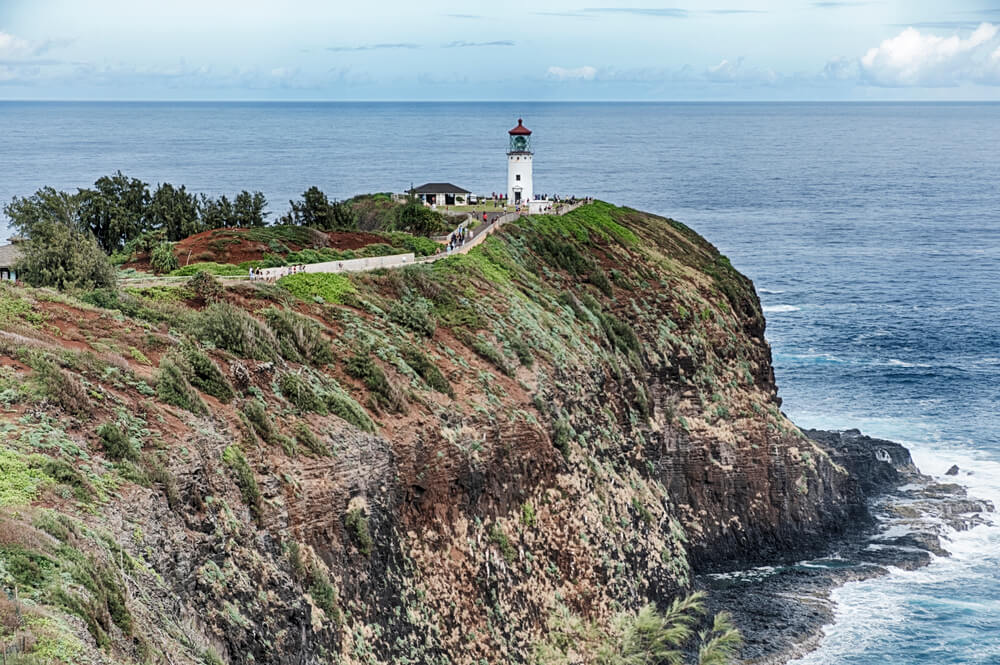The very thought of a place providing refuge to various species of wildlife makes a part of us want to visit the place.
The Kilauea Point is a narrow, lava peninsula protruding from the northern shore of Kauai. It was declared a National Historical Landmark in the late 1970s.
The Kilauea Point National Wildlife Refuge, operates with a goal of enhancing coastal ecosystems, restoring seabird breeding populations, and improving visitor services and environmental education.
Located on the north shore of Kauai, it serves as a perfect resting place for the two legged species, fishes, mammals and vegetation and aims at conservation of their habitat. There are signage all over the place conveying information about different species of wildlife in the region.
The Kilauea Point National Wildlife Refuge attracts more than 500,000 visitors annually owing to its breathtaking views and abundance of wildlife.
Kilauea Lighthouse
Known as Daniel K. Inouye Lighthouse, the Kilauea Lighthouse is 52 feet tall and is an integral part of the island’s history. The lighthouse also marks the northernmost tip of the island.
The idea of Kilauea Lighthouse was conceived out of the necessity for a landfall light for the ships coming into the island. It is said that the materials used for construction of the lighthouse were transported by sea because of bad roads. As of today, this towering monument is more than a hundred years old.
The area near the lighthouse offers an amazing view of the Pacific Ocean. Standing 200 ft above sea level, staring at the stunning visual before you and watching the fiery waves crash against the rocky shoreline is worth every penny of your visit.
A tour of the lighthouse is offered during different times of the day. The staff and volunteers are knowledgeable and equipped to help you with all the relevant information about the refuge.
Wildlife
Every year, thousands of seabirds migrate to this place for nesting, foraging or resting. The Kilauea wildlife refuge serves as a safe haven for a wide variety of seabirds who visit during different times of the year.
Some of the species that can be found here are;
- Laysan Albatross
- Red Footed Booby
- Black Footed Albatross
- Great Frigatebird
- Red-tailed Tropicbird
- Hawaiian Goose
- Pacific Golden Plover
- Wedge Tailed Shearwater
- Ruddy Turnstone
Being the northernmost point of the island has its advantages. Since the Kilauea point is located 200 ft above sea level, it serves as a good vantage point for admiring marine species like the Hawaiian monk seals, Humpback Whales, Spinner dolphins and the Pacific green sea turtles.
Watching the Hawaiian monk seals resting on the rocks with their tummy faced upwards, is absolute joy. The humpback whales are often spotted during winter, i.e, during the whale watching season. The marine life is highly endangered and special precautions are being taken by the refuge authorities for their preservation.
Along with seabirds and marine life, you can find a variety of plant species that are carefully preserved in the region.
Do grab a set of binoculars from the visitors center to get close and personal with the wildlife and nature.
Visiting Hours
The refuge is open Tuesday to Saturday, 10am to 4pm and is closed on major federal holidays. The morning hours are usually crowded and it’s better to plan your visit during the later hours for a more personal experience.
Also, place aside at least 30 minutes to completely internalize the experience and enjoy your time while you are here. The entry fee is $5 for adults 16 and above. The visit is free for children. All Federal Recreational Passes are honored here.
Driving Directions
If you’re starting from Lihue, drive north on the Kuhio Highway . Roughly after 20 miles, take a right onto Kolo road soon after the highway splits. Then, take a left along the Kilauea road and drive up to the end of the road to reach the Kilauea Point National Wildlife Refuge.
The parking space inside the refuge is limited, which is another reason not to visit during peak morning hours. Once you’ve parked your vehicle, you just have to take a short walk along the paved pathway to the Kilauea lighthouse.
You can also see the Kilauea lighthouse from the Kilauea viewpoint, on your way to the refuge entrance. But, it’s much more fulfilling when you walk till the end point because the view is simply amazing once you reach the shore.
The drive from Lihue will roughly take 45 minutes. You can add more fun to the mileage by stopping at popular destinations like Lydgate beach park, Wailua River, and donkey beach along the way.
In Conclusion
As a precautionary measure, do check the policies of the refuge as backpacks, pets, food and drinks are usually not allowed. The place has restrooms and drinking water facilities.
If you are visiting the north shore, do spend a few hours at the Kilauea Point National Wildlife Refuge as you might not get the opportunity to visit a Wildlife reserve of this scale every now and then. Also, it is a perfect example of what happens when history is blended with nature!



